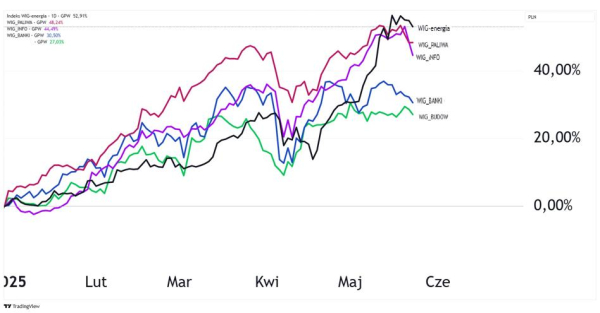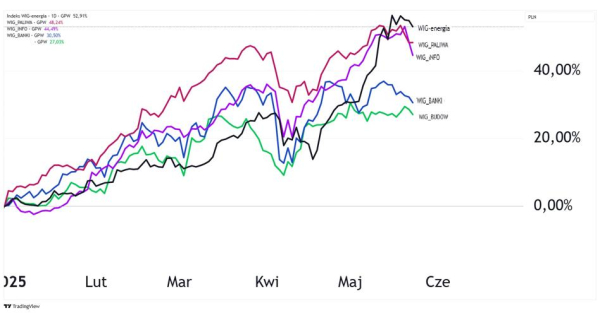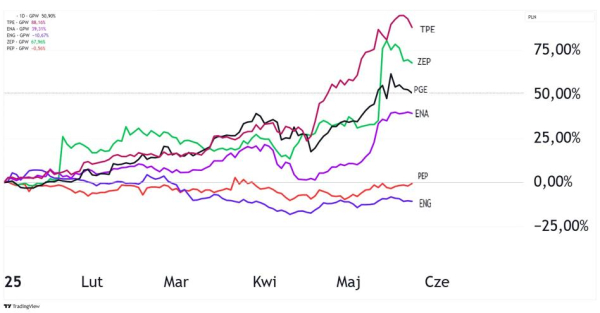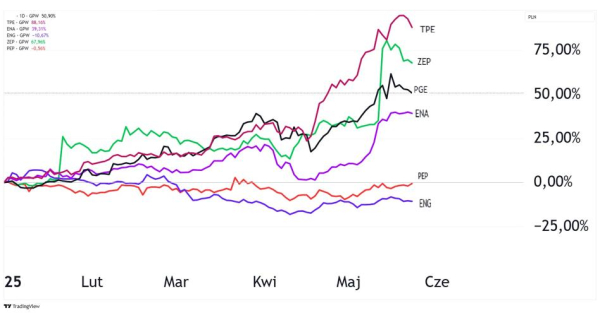This year, there is no stronger growing sector on the WSE than energy. After years when banks, construction, gaming, and even chemicals and clothing ruled, WIG-Energy is taking over the role of the industry leader. It has a real chance to shine the brightest, which is all the more difficult because the market is in a bull market and the rates of return of most sectors are more than satisfactory. Energy on the WSE offers good liquidity, and it showed its strength by recovering from a blow from the Prime Minister himself.

In 2024, WIG-Gry performed best among the sectoral indices on the WSE, gaining almost 28%. In turn, in 2023, construction performed best with an increase of 87%. When the bear market continued in 2022, an increase of less than 11% was enough for WIG-Chemistry to win. In turn, in 2021, WIG-Odzież increased by almost 84%, and second place was taken by WIG-Banki (81%), which was also the vice-leader in the sector in 2023 (77%). In 2020, WIG-Górnictwo performed best on the WSE.
At the end of May 2025, while the WSE is experiencing a super bull market, which is being discussed by the world media, and the profitable WIG is growing by 30%, the profitable industry indices also have a new leader. WIG-Energia has gained 50% since the beginning of the year so far and it seems that it has an appetite for more.


Industry indices from the Warsaw Stock Exchange with the highest YTD rates of return (tradingview)
Difficult years for the energy sector
In recent years, the new energy sector has looked poor. Although in 2017 WIG-Energia gained 17% (mid-point), in 2018 it lost over 19%. In 2020 it gained only 4%, in 2021 it grew by over 18%, but against the background of the market it was only the 10th industry result. Politics weighed on us, the summary of which can be found in the words of Krzysztof Tchórzewski, the Minister of Energy from 2015-2019, who said, among other things, that “it is better to spend money on PGE's assets than on dividends”, which, as it turned out, applied to all state-controlled energy groups for years.
The year 2022 was a surprise, because although everything was in a bear market, energy prices were rising rapidly, but investors watched with amazement as the prices of shares of industry companies fell during the boom in the sector. Ideas were considered to collect excess profits through taxes, but this was ultimately abandoned, the government announced plans for a nuclear power plant, PKP Energetyka was repolonized, and there was still the issue of Turów, or the plan adopted by the government in March to spin off coal assets to NABE. A lot was happening, but WIG-Energia still lost almost 13 percent.
The Minister gives and takes away
Read more…
The last two years have been very different. In 2023, the energy sector gained 33%, but this was below (!) the average growth for 14 sector indices, which was 35%. In 2024, the energy sector was again in the red, losing 11.2% over the entire year, which was the result of chaos brought about by the change of government, which had no idea what to do with the energy sector (there was even an idea to rigidly connect coal supplies from mines to power plants), and certainly did not know how to communicate this to the market, hiding behind further analyses regarding the separation of coal assets.
It started to be more about doing than talking
Leaving them in the structures of large groups (PGE, Tauron and Enea) was supposed to block obtaining financing for investments related to the energy transformation. Possession of “dirty” coal assets made access to loans and insurance difficult, there was no money from the KPO, because the EC blocked it for political reasons. The deadline from the previous version of the Capacity Market Act, according to which the most emission-intensive generating units were to be eliminated from the market from the second half of 2025, was also hanging over our heads.
In January this year, however, the Sejm passed an amendment to the Capacity Market Act, enabling further support for high-emission generating units, at least until the end of 2028. In March this year, Minister of State Assets Jakub Jaworski said that there are mechanisms for coal assets to support their existence, which means they can continue to generate positive EBITDA. Although he noted that further analyses are needed for this, it is a factor that should be taken into account.
It is worth recalling that stock market analysts drew attention to this already in 2024. Trigon DM experts indicated in December last year that the energy sector could be “investable” without separating coal assets. What's more, they added that this topic may return to the government agenda only in a few years, before the risk of significantly negative results in 2029.
It seems that foreign investors noticed this the fastest. A year ago, in May 2024, the London-based Helikon Investments Limited revealed itself in Tauron's shareholding through one of its funds. In the following months, it gradually increased its involvement, and in the meantime, it also revealed itself in Enea's shareholding. In February this year, the US investment giant Goldman Sachs revealed itself in Tauron's shareholding.
“The interest of global investors such as Goldman Sachs and Helikon Investments is a clear signal that the market appreciates the value of Tauron and the direction we took in March 2024,” said Grzegorz Lot, CEO.
The market also appreciated the reported results, which, although in selected quarters were already much better than the consensus in 2024, were still burdened with significant write-offs throughout the year. Already in the new year and with a so-called clean slate, there were increasingly greater positive surprises, and the results driven by the energy distribution segment exceeded the wildest expectations. Enea, Tauron and the largest PGE began to count profits in billions of zlotys.


YTD rates of return of the largest companies in the WIG-Energia portfolio (tradingview)
In addition, a light appeared at the end of the dividend black tunnel, which was the recommendation of the Enea management board to pay a part of the profit to shareholders, more about which in the article “A thaw in the state energy sector? There is a chance for the first dividend in 8 years”. It was surprising because in February, for example, analysts from DM BOŚ wrote in one of the recommendations that they did not expect any of the three companies (Enea, Tauron, PGE) to pay a dividend in 2025-2027. What's more, if any of them were to do so, it would be Tauron, in their opinion.
A thaw in the state energy sector? There is a chance for the first dividend in 8 years
There is a chance that shareholders of one of the four largest energy groups in Poland, controlled by the state, will receive a dividend from last year's profit.
Read more…
It should be noted that large amounts of money have finally started to flow from the KPO. In total, within the Energy Support Fund financed from the KPO, it is to be almost PLN 40 billion, which will go to Tauron, Energa, PGE and Enea for the modernization of power grids. These were no longer just promises of politicians with large amounts in the background (these still appear, such as PLN 600 billion for energy in the next 10 years) and ambitious plans of CEOs in strategies, but stock exchange announcements about signed contracts, such as the one from Enea for over PLN 9 billion.
WIG-Energy like Tyson Fury
Investors are so convinced of the current attractiveness of investing in the energy sector that even the “left hook,” to use boxing terminology, that Prime Minister Donald Tusk dealt to the sector only caused a momentary panic on stock exchange prices. Ultimately, WIG-Energia quickly recovered after Tusk's blow, like Fury after Wilder's blow in 2018.
Let's just say that Tusk's blow, like Wilder's, was no small feat. In mid-April, at the European Forum for New Ideas in Warsaw, the prime minister said no less than that state-owned companies, such as those in the energy sector, also listed on the stock exchange, are not necessarily supposed to maximize profits, but above all to take care of the country's security.
WIG-Energia fell 4.5% that day. A month later, the index was 38.6% higher and set its highest level since July 2015. Tauron's share price has already broken its historic peak, PGE is at its highest level in three years, Enea since 2011. It is hard not to perceive this in any other way than in terms of the strength of the sector and the belief that it is currently the first choice of capital operating on the WSE. Investors must have interpreted Tusk's unfortunate remark as an element of political publicity, rather than an actual attempt to manually control the corporations.
They focused more on what was announced in the press releases, and there were billions in profits, the announcement of the first dividend in many years from a “state-owned” energy company, contracts for KPO money, and all this with low stock market indices, which for years reflected the discount applied by investors to state-owned companies, especially energy companies. More and more investors began to open their eyes more widely to what was actually happening in the sector, and previously skeptical analysts are following them.
State Treasury companies to invest billions in energy
Four state-owned companies will allocate PLN 600 billion for investments in energy in the years 2025-2035, the Ministry of State Assets announced on platform X. Orlen is to carry out investments worth PLN 350-380 billion, Tauron – approximately PLN 100 billion, Enea – PLN 107.5 billion, and PGE – PLN 18 billion for energy storage and PLN 75 billion for its distribution.
Read more…
Those from DM BOŚ recently admitted to changing their perception of the stock market energy sector. “Firstly (and most importantly), we see a major change in government policy, which now seems to strongly support the EBITDA of energy companies listed on the WSE. Secondly, we have the impression that from the perspective of minority shareholders, the government's approach to companies with State Treasury shareholding has improved. Thirdly, it seems that the negative factors operating in the energy sector have not managed to significantly affect the prices of energy companies on the WSE,” they wrote in a report on May 16. At that time, WIG-Energia was the highest this year and for many years.
To sum up, it seems that the energy sector is able to shine the brightest on the WSE this year as an industry. Especially since banks are slowly losing their shine, and certainly the potential for such dynamic growth as in recent years, since interest rates are to be lowered. Of course, there are other growing sectors, but the energy sector, like no other on the WSE (apart from banks), offers shares of so many large companies with billion-dollar valuations. Let's add that it is not only PGE, Tauron and Enea, as well as Energa, almost entirely absorbed by Orlen, but also ZEPAK and Polenergia (both without a state element). The offered liquidity may be crucial for large capital, assuming a further bull market on the WSE and the naive belief that politicians will not interfere in the meantime.
Michal Kubicki






